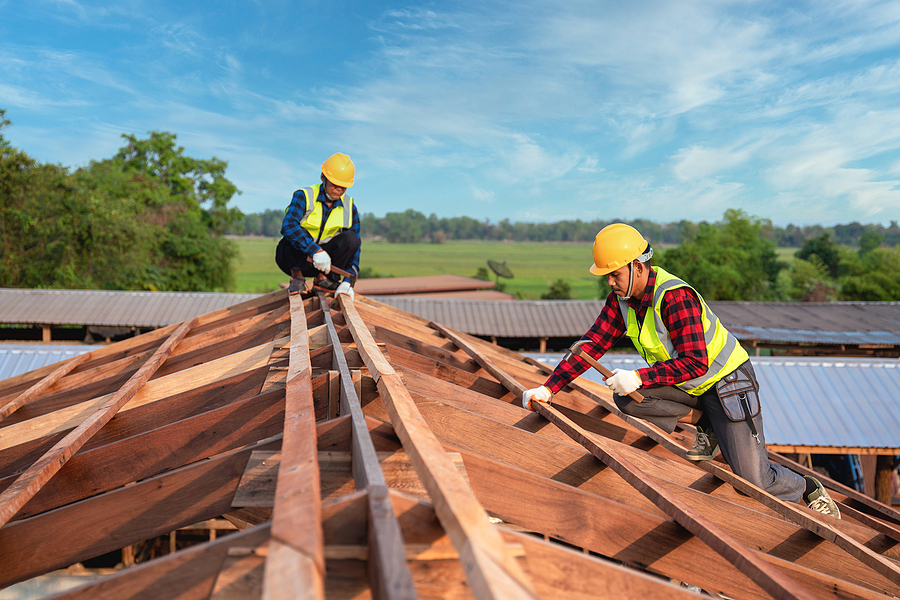Tapered Systems (To Add Slope) in Jacksonville, FL
Flat roofs can be a simple and cost-effective roofing solution, especially when building commercial buildings. But these flat roofs also come with certain disadvantages, especially when it comes to mitigating leaks and other water damage over time.
Tapered roof systems were developed to solve some of the limitations of these flat roof designs, while also creating new advantages regarding not only roof installation and maintenance, but also energy efficiency and other structural benefits. If you’re looking for cost-effective solutions to add slope and durability to a flat roof, these tapered systems might be exactly what you're looking for.
To discuss the possibility of adding a tapered roof system to your building, contact us at (904) 396-1546.

What is Tapered Roof Insulation?
Tapered roof insulation is a type of rigid installation that can be installed to essentially add slope to a flat roof. When you install (tapered roof insulation, slope) is built into the design of the insulation panels to outfit the building’s roof with enough slope to properly drain off water and reduce the risk of pooling water on the roof’s surface.
By turning the insulation itself into the underlying structure that adds slope to a roof, tapered roof insulation essentially performs two important roles at once—and does so while delivering a number of valuable benefits to the building itself.
Contact Us for a Free Quote
"*" indicates required fields
The Benefits of a Tapered Roof System
For buildings with a flat roof, a tapered roof system can offer a number of significant benefits, including both short-term gains and long-term rewards.
These benefits include:
- Improved roof protection from ponding and other water damage. By adding a slope to your flat roof, you can create a system for proper drainage that eliminates water ponding that is notorious with flat roofs—and which will inevitably result in leaks and water damage to the building.
- Enhanced insulation, resulting in lower heating and cooling costs. Solid pieces of tapered insulation provide exceptional protection against heat transfer and heat loss through your roof. As energy efficiency requirements for buildings continue to increase, a tapered roof system can significantly improve the energy envelope of a building, making it possible to reduce your utilities costs.
- Cost-effective roof installation. While the cost of a tapered roof system can depend on the desired slope of the roof—which will affect the volume of insulation required for your building—most tapered roof systems are significantly cheaper on a per-square-foot basis than even affordable roofing materials like asphalt shingles. The maintenance needs of a tapered system are also greatly reduced from the maintenance needs of a flat roof.
- Reduced risk of pests in your roof and attic. Because the insulation is solid and water damage is prevented, pests won’t be attracted to wet, protected interior spaces where they can build a home.
- Increased lifespan for your roof. A properly installed tapered roof can last for 30 years or even longer on some homes.
To learn more about tapered roof system installation, contact us at (904) 396-1546.
How Do You Apply Tapered Insulation?
Tapered roof systems are simple for professional roofers to install, although they require advanced measurement and planning to make sure the tapered roof system provides a proper fit for your building.
These roof systems are modular, with sloped pieces being installed in layers from the ground up. Fill pieces are installed underneath to provide insulating support for the rest of the structure.
In most cases, a roof-grade insulation adhesive is used to bind the tapered insulation to the roof’s surface, and to connect individual pieces of insulation together for a uniform, leak-proof bond.
How Do You Calculate Tapered Roof Insulation?
When it comes to calculating the size, slope and/or cost of a tapered roof system, this process should always begin with a site assessment by a roofing contractor who provides tapered roof system installation.
Each tapered system is custom-built for the specific needs of the building where it’s installed. From the footprint of the flat roof to the desired slope, the design and materials can be precisely calculated so that property owners know exactly what they can expect to pay for their tapered roof.
A site assessment also helps the roofing contractor assess potential challenges to be addressed when designing and installing the roof. Unusual roof footprints are just one of the complications that needs to be accounted for during the design phase—otherwise your tapered roof may not provide the drainage, coverage and insulation you are seeking from this roofing solution.
If you’re tired of dealing with leaks and other challenges of a flat roof—or you’re simply looking for a cost-effective option for upgrading your building’s roof—a free site visit and consultation is the best way to get answers to your questions. Contact a tapered roof installer today to get started!
Contact Us for a Free Quote
"*" indicates required fields

